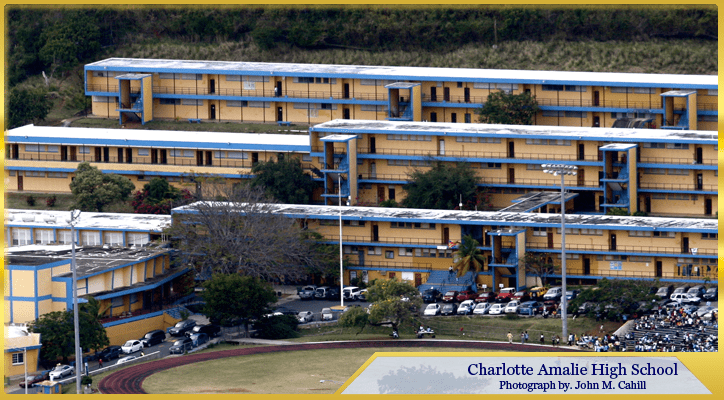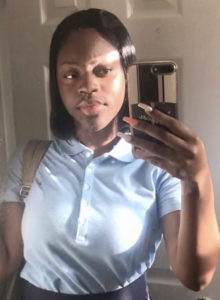

This is the final installment in a four-part series on virtual schooling in the U.S. Virgin Islands.
Princess Atemazem has three older brothers, so when she finished her stint at Addelita Cancryn Junior High, she thought she had a good idea of what to expect from high school, and she was looking forward to it. She was scheduled to begin her freshman year at Charlotte Amalie High School on Sept. 5, 2017.
But Irma got there first.
That was the very day that the hurricane destroyed or severely damaged thousands of buildings across St. Thomas and left the CAHS campus in shambles. It turned out to be an omen for all the students who started high school in the Virgin Islands that year. Now, as they head toward graduation they are leaving behind high school careers like none other before them.
“We didn’t have a first day of school. Nothing,” said Atemazem, who agreed to share her story with the Source as an example of many similar tales throughout the territory.
Two weeks after Irma, Hurricane Maria hit the islands, devastating St. Croix and exacerbating the earlier damage on St. Thomas.
It was Oct. 10 before Atemazem was finally able to begin her freshman year. She’d spent the previous four weeks waiting and waiting.
“That month was like forever,” she said. “It felt way longer … I’d been home, doing nothing.”
Once again she was looking forward to classes and to seeing friends.
“I was so excited to be back at school,” she recalled. But she soon discovered, “It was very different.”
Cancryn school had been destroyed. The junior high students were shifted to the CAHS campus and the two schools were on split sessions. The younger students were in class from 8 a.m. to noon and the older ones from noon to 4 p.m.
“Honestly, it was very hectic,” Atemazem said.
Although it was somewhat functional, CAHS had been badly damaged.
“They were still fixing it up,” Atemazem said. Many of the classrooms were not usable, so the auditorium was pressed into service.
There could be as many as a dozen classes taking place at the same time in different sections of the auditorium. It was also used as the overflow space where students who arrived early for their shift were sent to wait until the younger students left.
“It looks big, but it’s not that big,” Atemazem said. “If you had a choice, you would come to school exactly at noon,” to avoid waiting in the auditorium, but some students didn’t have a choice; they came when the school bus brought them.
Atemazem expressed sympathy for the teachers, wondering aloud how they could even hear their students.
“It was packed and chaotic in there,” she said. Still, “At least we had that. Some students (at other schools) weren’t even back in school yet.”
The gymnasium was not usable her first year and athletic programs were scaled back. The field was all right, so track and field events could still be held. Sometimes CAHS teams practiced at Eudora Kean High School.
There were few if any extra-curricular activities at least for the first semester, Atemazem said.
“My sophomore year, now, we were supposed to start Sept. 4,” she said. But the opening day was pushed back to Sept 27 to allow for the completion of the construction of modular classrooms.
The junior high school students were housed there. That freed up some space in the main buildings, but it also meant a further erosion of sports because the modular classrooms were on the track and field. All sports practice had to be off-campus, and obviously, there were no home games.
Things eased considerably with the end of split sessions in the same building, but there were still some accommodations necessary because the two schools continued to share a campus. Atemazem said the CAHS school day, which had run from 8:10 a.m. to 3:10 p.m., was rescheduled to run instead from 8:30 a.m. to 3:30 p.m. That allowed for staggered arrival and departure times for the two schools.
It was a minor adjustment but it did affect students who worked after school and had to try to change their work schedules, she said.
In the fall of 2019, “We started junior year on time,” Atemazem said. The Cancryn students had been moved out of the modular classrooms “next door” to the Lockhart School, and CAHS students were moved into the modulars while more repairs were made to the main buildings.
The modular buildings were comfortably air-conditioned, which was a treat, she said. The cafetorium was a little small, perhaps, and served “grab and go” lunches. It was hot outside where she met with friends to eat lunch, but overall, Atemazem said her junior year was probably the best of her high school years.
It wasn’t until the second semester that most people had even heard of the coronavirus or Covid-19, the disease it causes.
“Junior year was normal until March 15,” Atemazem said.
That’s when the government closed schools in an effort to curb the virus spread.
“We were sent home for two weeks,” Atemazem said. That was the initial idea, but they were out for the rest of the school year and still remain at home, attending classes via the internet. In-person learning is supposed to resume for young students soon, but grades four through 12 will continue with virtual classes until at least the start of the next school year, September 2021.
The unexpected switch to virtual classes was not easy, Atemazem said.
“It was so different. Teachers were confused too.”
She said many of her peers are still struggling with virtual learning, while she herself has “no problem” with it and feels she has gotten used to it. Still, she prefers traditional classes.
“I’m a visual learner, I like seeing the teacher at the blackboard.”
And, sometimes, it’s hard to turn off distractions at home and to get others to realize that she is actually “in class” even if she’s in her room. Overall, she thinks her education suffered somewhat.
“I believe if it was in-person, I would have learned way more,” she said.
The last four years are extraordinary not only for the effect they had on academics.
Like other V.I. students, Atemazem saw many friends and classmates move off-island after the hurricanes. Some went to the mainland, some went to other Caribbean islands where they had family. One of her closest friends was gone for two years. Most returned in a year or two; some still have not come back.
It’s traditional at public high schools for each grade to hold a special week of activities; those are staggered throughout the year. For seniors, there is also Introductory Night, a showcase of talent and camaraderie that usually takes place toward the end of the first semester.
The abrupt end of Atemazem’s junior year meant both junior and senior weeks were canceled. This school year, there are no class weeks, and her senior class Introductory Night was canceled too. She was picked for Quiz Bowl last year, but it was canceled along with many other extra-curricular activities.
“I’m not sure about prom this year,” she said, “and I’m not sure about graduation.”
She’d sort of like to know whether those events will take place, but she’s not sure she really cares. She says she feels like she has “senioritis” – that sense of detachment many feel toward the end of high school. It may be exaggerated in this case.
“At this point, I’ve shut down,” she said. “I would appreciate my diploma and just move on at this point.”
In the fall, she’ll be moving on to Georgia State University in Atlanta, where she has been accepted to study chemistry in preparation for further study and eventually a career in pharmacy.
Previous Installments in the Series
Part 1: The Next Crisis is Here: Learning Lags as COVID Rules
Part 2: Distance Learning: A Tale of Qualified Success
Part 3: What Are Students Missing Beyond the Screen?





